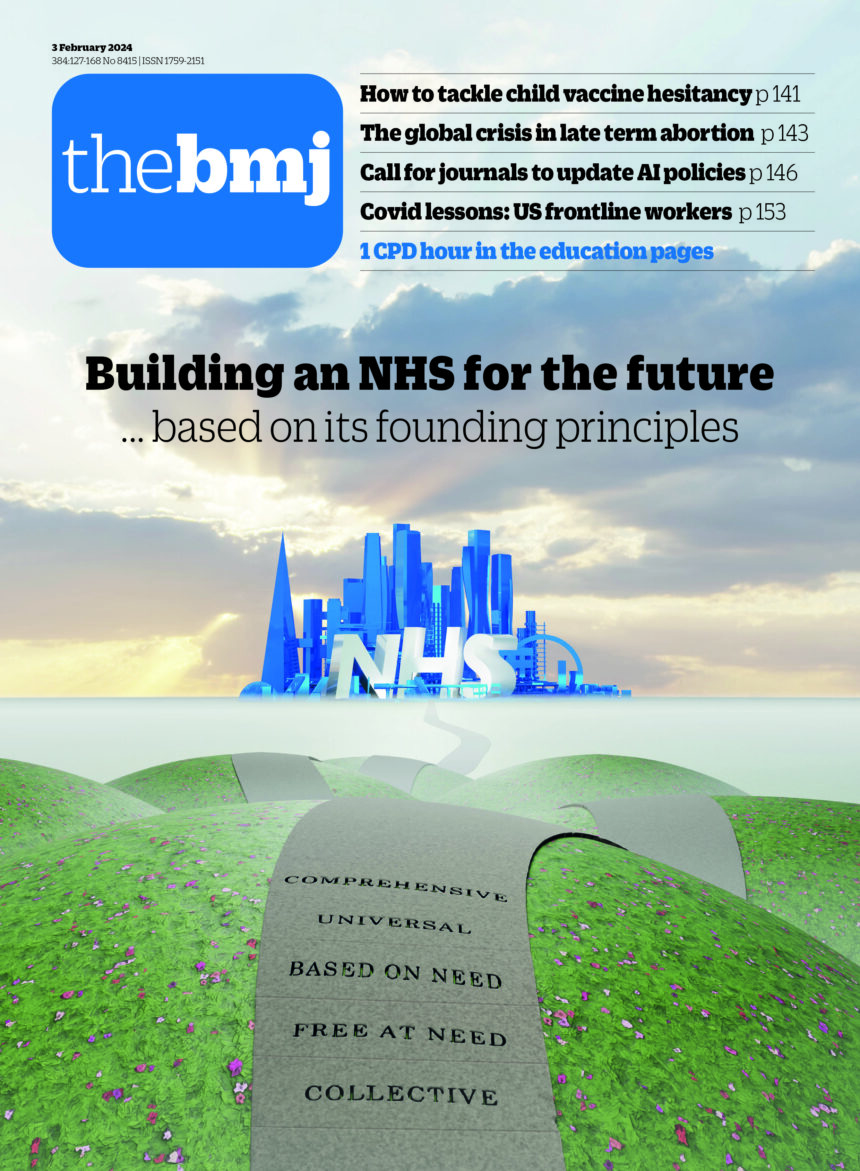During the devastating global Covid-19 pandemic, one country stood out: The United States experienced “incredibly high” death rates compared to its peers.1 The 1.16 million Americans killed by covid-19 represent 16% of global deaths in a country that has 4% of the world’s population.2 One in three Americans know someone who has died from covid-19,3 It is estimated that around 300,000 children have lost one or both parents,4 and there is a substantial burden of long covid.5
The BMJs new series on the lessons of covid-19 in the USA (www.bmj.com/collections/us-covid-series) highlights the societal actions needed to avoid the loss of an additional million citizens during the next pandemic and to improve and protect the health of the population more generally. The authors of the articles in this series call for a set of crucial systemic reforms that we believe should be at the heart of the platforms of the candidates for the 2024 US presidential election. The series follows previous BMJ series to inform the British investigation into covid-19 (www.bmj.com/covid-inquiry) and on responsibility for Canada’s response to covid-19 (www.bmj.com/canada-covid-series).
Causes of pandemic chaos
The American series documents the many complex and interrelated causes of America’s poor response to the pandemic, underpinned by two key contexts. The first concerns the country’s pre-existing structural and systemic characteristics, which amplified the impact of the pandemic. These include gaps in health and public health systems, lack of social safety nets and workplace protections, social inequalities and systemic racism. These same characteristics also contribute to the United States’ poor performance on many health indicators compared to other wealthy countries.6 From 2010 to 2019, even before Covid-19, life expectancy in the United States stagnated while it increased in high-income countries,7 and inequalities in health and health care have widened.8
During the same period, the U.S. Centers for Disease Control and Prevention saw its base budget and public health emergency preparedness activities cut.9 From 2010 to 2020, per capita spending for state public health departments decreased by 16% and for local health departments by 18%.9 As the Trump administration bungles the federal response,ten State and local health departments, hollowed out, were ill-equipped to step into the breach.9
Deeply entrenched inequalities have contributed to the devastating consequences of the pandemic. The United States experiences greater income inequality and more limited worker protections than its peers,11 and precarious employment was on the rise even before covid-19.12 These are the main reasons why the country has experienced higher covid-19 death rates than its more egalitarian counterparts,13 and why pandemic deaths in the United States were modeled so closely on social class.14 Additionally, a history of pervasive structural racism has manifested itself in many aspects of society, which, unsurprisingly, has led to stark racial inequalities in the United States in who lived and who died.15
A second context is that while the United States had numerous scientific resources, exemplified by the success of Operation Warp Speed to accelerate vaccine development and the Covid-19 Prevention Trials Network to mobilize critical research, government at many levels has demonstrated a surprising inability to generate reliable information. , communicate it in a timely and consistent manner, and translate it into sound policy. These failures started at the top. President Trump has constantly lied about the pandemic,ten1617 with terrible consequences.18 His suggestion to inject disinfectant into people infected with covid-19 came to symbolize the chaotic presidential communications during the first year of the pandemic.19
Despite its scientific resources and decades of pandemic preparedness exercises, the country has struggled to generate scientific evidence on viral transmission and the coordinated policies needed to prevent such transmission. Poor communication of existing evidence has also contributed to confusion and delayed or inappropriate actions, contributing to the partisan difference in the speed with which U.S. states have instituted public health protections and to excessive death rates during the pandemic. .20 especially after vaccines become available.21
The absence of timely evidence and late or incomplete reporting of what was known also led to overreach, which itself had adverse consequences. For example, even after studies showed that fomite transmission was rare and transmission outdoors was much less common than indoors,2223 some municipalities and states have kept parks, playgrounds and beaches closed. Even after research showed that schools could reopen safely with basic public health measures, too many jurisdictions continued to teach only online.24 Too often, lessons have failed to learn from evidence-based harm reduction approaches that have successfully contained other pandemics, such as HIV/AIDS.25 Communication failures were compounded by federalism – the division of power between the national government and the 50 US states – which ensured that the response to Covid-19 depended on zip code.26
Successes to build on
But despite these failures, the pandemic has also shown the United States how government and society can play a different role in protecting health. In addition to the rapid development of vaccines, financed by public funds, many public policies have been put in place to help citizens and reduce deaths. These included expanded unemployment benefits, food assistance programs, an eviction moratorium, expanded children’s health insurance coverage and Medicaid enrollment, and federal funding for modernization of public schools. These strategies have had measurable social and health benefits.27 Particularly relevant to the 2024 U.S. presidential election, they illustrate how a range of government actions, beyond health insurance, can be critical to protecting health during the next pandemic and beyond.
THE BMJ the series includes articles on the effects of systemic racism and economic inequality; mass incarceration and poor prison health; inequalities in the labor market; legal infrastructure; and the diminished role of the public sector. The goal of this series is not to place blame – there is much to be done – but to look forward and outline critical steps to transform public health and preparedness in the United States and improve health of the population more broadly.
Footnotes
-
Correspondence to: G Yamey gavin.yamey@duke.edu
-
Competing interests: We have read and understood the BMJ policy on declaration of interests and declare the following. ADR and GY were guest editors of The BMJ series. GY has received research funding for his institution to study pandemic preparedness and response from the WHO, the Bill & Melinda Gates Foundation, Carnegie Corporation of New York, the Economic and Social Commission of United Nations Asia and the Pacific, the Economic and Social Research Council, and Duke. Global Health Institute. He was a member of the Covid-19 vaccine development task force hosted by the World Bank and participated as an unpaid academic advisor in the consultation process that led to the launch of Covax. He served as an unpaid advisor to the Justice Collaborative, helping to organize open letters to the Trump administration and the governor of North Carolina, signed by public health experts, calling for decarceration during the covid-19 pandemic. In a court case in which seven Manitoba churches and three individuals claimed that Manitoba’s public health measures violated their Charter rights, he provided free scientific advice to the legal team arguing in favor of the health measures public. He writes an unpaid column for TIME review. ADR reports research funding to its institution to document and study health inequities in covid-19-related outcomes. She also served on the National Academy of Sciences’ 2020 committee that developed a framework for the equitable allocation of vaccines against the novel coronavirus.
-
Provenance and peer review: commissioned; no external peer review.
-
This article is part of a series commissioned by The BMJ (http://bmj.com/collections/us-covid-series). Guest editors were Ana Diez Roux and Gavin Yamey and the editor-in-chief of The BMJ was Jocalyn Clark.




